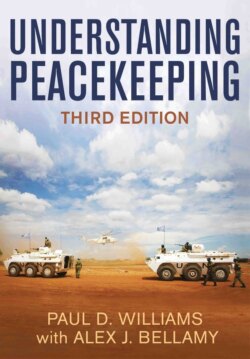Читать книгу Understanding Peacekeeping - Alex J. Bellamy - Страница 48
4.1 The transformation of peace operations
ОглавлениеA mix of factors account for the triple transformation of peace operations after 1988 (see table 4.1). On the demand side, all bar one of the UN missions created between 1988 and 1993 (UNIIMOG) were ‘brokered requests for UN assistance’ (Durch 1993: 17). In other words, they were formally requested by peace agreements or ceasefires brokered by third parties and endorsed by the conflict parties. In most cases, the UN played the role of broker, but there were a number of exceptions: UNTAG was the product of a US-led mediation effort through a Contact Group of Western governments and UNAVEM II the product of an initiative spearheaded by Portugal, the Soviet Union and the US (Durch 1993: 17, 20–2). The majority of peace processes addressed conflicts that preceded 1988, and all of those had some connection to Cold War politics. In other words, this period witnessed the conclusion of many civil wars that had been provoked and sustained by the Cold War’s ideological struggle. As the superpowers withdrew their patronage, so it became harder for local clients to maintain their war effort. This created powerful incentives for belligerents to search for a negotiated settlement, and peace operations were an important part of supporting that process. The early success of the smaller operations launched in 1988 and 1989 reinforced that idea.
On the supply side, each country had its own reasons for providing peacekeepers, but at least three general factors played a role. First, the disintegration of the Soviet Union created a much more proactive Security Council. Between 1990 and 2002, only twelve draft resolutions were vetoed – by far the lowest rate of vetoes since the UN was established. The US cast nine of these, six in response to draft resolutions critical of Israel. In comparison, between 1945 and 1990, 238 vetoes were cast. Cooperation between East and West played a major role in resolving the Central American wars and conflicts in Afghanistan, Namibia, Angola and Mozambique. Moreover, from the late 1980s, China began to adopt a more positive stance on peace operations, increasingly accepting that the UN Security Council had a legitimate role to play in the resolution of conflict and the amelioration of human suffering (Fravel 1996).
Table 4.1 Explaining the triple transformation
| Demand | Supply |
|---|---|
| 1 End to civil wars brokered by third parties | 1 More cooperative Security Council |
| 2 Request for peace operations to monitor and implement peace accords and ceasefires | 2 Globalization of media, democratization, and human rights creates government interest |
| 3 Recognition that peace operations can play an effective role (after 1988–9) | 3 Peace dividend: end of Cold War free military capacity |
Second, the wave of democratization, the spread of human rights and the so-called CNN effect led more governments to see peace operations as ‘politically desirable’ (Jakobsen 2002: 274). As the former UN Secretary-General Pérez de Cuéllar suggested in 1991, ‘we are clearly witnessing what is probably an irresistible shift in public attitudes towards the belief that the defense of the oppressed in the name of morality should prevail over frontiers and legal documents’ (in Scheffer 1992: 4). These three trends brought together a new and wide coalition of states willing to provide peacekeepers, including the great (Western) powers, internationalist-minded middle powers, and a range of other states, in articulating a new role for peace operations and the UN.
Finally, with the end of the Cold War and no major new strategic challenges on the horizon, governments had more military capacity to commit to peace operations. Moreover, some militaries declared an interest in taking on such roles in order to justify their budgets and guard against excessive cuts as part of the post-Cold War ‘peace dividend’ (Freedman 1998: 34–5; Jakobsen 2002: 273).
These factors also impacted the willingness of states and some regional organizations to undertake non-UN peace operations, especially in areas where the UN was unwilling to operate, notably in the former Soviet Union and parts of sub-Saharan Africa.
